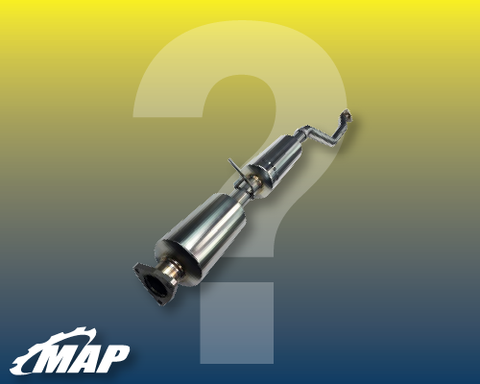A downpipe in a turbocharged car is an essential component to the exhaust system. The downpipe connects to your vehicle's turbine housing and helps to control emissions by reducing the temperature in the exhaust gas. It also reduces back pressure on your engine so it can run more efficiently.
In this article, we will dive deeper into the depths of this important stainless steel component.

How does a downpipe work?
Downpipes are meant to meet emissions standards and provide enough air movement for a stock vehicle’s performance requirements. Catalytic converters, a small pipe diameter (which reduces heat transfer), and restrictive angles all contribute to low flow rates on a factory downpipe that affects how well your car performs.
What is a catted downpipe?
So we know from the above that an automotive downpipe is an effective solution to control emissions by reducing the temperature in exhaust gas. To do that, the downpipe’s cat needs to filter gases into a large area. Without going into too much of the science involved, the catalytic converter is designed to reduce pollution by converting harmful emissions like carbon dioxide and nitrogen oxide. The honeycomb filter design inside the converter helps these gases come in contact with more areas, which makes it more efficient.
The metals act as a catalyst and react with the emissions and shift harmful exhaust fumes to less dangerous pollutants. The contents inside need to be incredibly hot for the conversion to work efficiently, which is why ceramic is used. Ceramic metal heats fast and stays very hot for a long time. Without the catalytic converters, gases like nitrogen oxide, carbon monoxide and other hydrocarbons are quickly emitted into the atmosphere, causing harmful environmental air pollution.
Do downpipes add horsepower?
Yes. Performance catted downpipes nowadays have been shown to increase horsepower. An aftermarket downpipe with catalytic converters will add 10 to 20 horsepower on average, and that gain is noticeable anytime the turbo spools.
Is it easy to install a downpipe?
Yes. Downpipes are one of the easiest components to install on your car. Depending on whether you're performing the installation on a jack stand or lift, downpipe installs can take up to one hour. This obviously depends on if you know what you're doing, following along to a tutorial, or you're performing a whole muffler delete.
Will a downpipe make my car louder?
Yes. Aftermarket downpipes certainly will make a car louder with a more aggressive exhaust note. Aftermarket ones are louder than stock because they reduce the backpressure that occurs in restrictive exhaust pipes.
Will a downpipe void my warranty?
No worries–Installing an aftermarket downpipe doesn't void your vehicle's entire warranty. If you are a United States resident, then you're protected by the Magnuson Moss Warranty act. So for downpipe installation, you may lose warranty only for your exhaust system, not the whole vehicle.
Downpipe vs header
For those who want to get their hands on some horsepower, there are two popular modifications: upgrading the downpipe or header. What's the difference between the two, and which one gives you more power gains? We have the answers!
What is a header on a car?
Some people believe that headers and downpipes are the same, but they’re not. A downpipe and header play similar roles for escaping emissions, but are different installations for different reasons.
Headers are simple bolt-on accessories used to improve an engine's performance. Headers make it easier for the motor to push exhaust fumes out of the exhaust system. They connect to one or more cylinder heads and evacuate gas exiting out of that cylinder head through your car's muffler.

How much horsepower do headers give you?
On average, a good set of aftermarket headers give a boost of 10-20 horsepower.
So how does a header compare to a downpipe?
Essentially, downpipes are for turbos only, while the similarly-tasked header is for non-turbocharged vehicles. Technically you can still use headers with a turbo, but it would have to be a custom turbo system that connects to the turbos in the exhaust after installing the header base.
Why do I need a downpipe?
An aftermarket downpipe is an essential component when it comes to getting the most power possible from your stock turbo. With a free-flow exhaust system, you can expect higher levels of performance! It's a vital component in moving the exhaust gases through the system as efficiently as possible. You'll be able to outperform your competition on track day, while upgrading your exhaust note as well.
Supra downpipe
For those looking to take advantage of that extra power, this Supra downpipe is essential. Made from 304 Stainless steel and hand welded in the USA, this is a top quality component. And it's simple to install!

Evo X downpipe
For that ultimate exhaust flow and fast turbo spool, check out this exceptional Evo X downpipe for racing use only. This mandrel bent downpipe has a simple bolt-on installation that mounts to the stock turbo or an upgrade kit.

WRX downpipe
Our Subaru WRX downpipe is top-notch. It allows spent exhaust fumes to escape quickly out through to the exhaust system, increasing horsepower and torque through the entire vehicle.

MK7 downpipe
If you're looking to enhance your power and torque after installing a new turbo on your MK7 GTI, then this high-flow MK7 catted downpipe upgrade does the trick brilliantly. Its simple installation, emission-ridding process, and power gains are truly second-to-none for the MK7.

Need more aftermarket downpipe or car exhaust system parts information? We are standing by to assist you in your journey. Get in touch with MAP’s experienced experts today.




Comments (0)
There are no comments for this article. Be the first one to leave a message!